Fukuda Denshi Co DS7100 Patient Monitor User Manual DS71v1 1 FA 03 Vital 005
Fukuda Denshi Co Ltd Patient Monitor DS71v1 1 FA 03 Vital 005
Contents
Manual 5
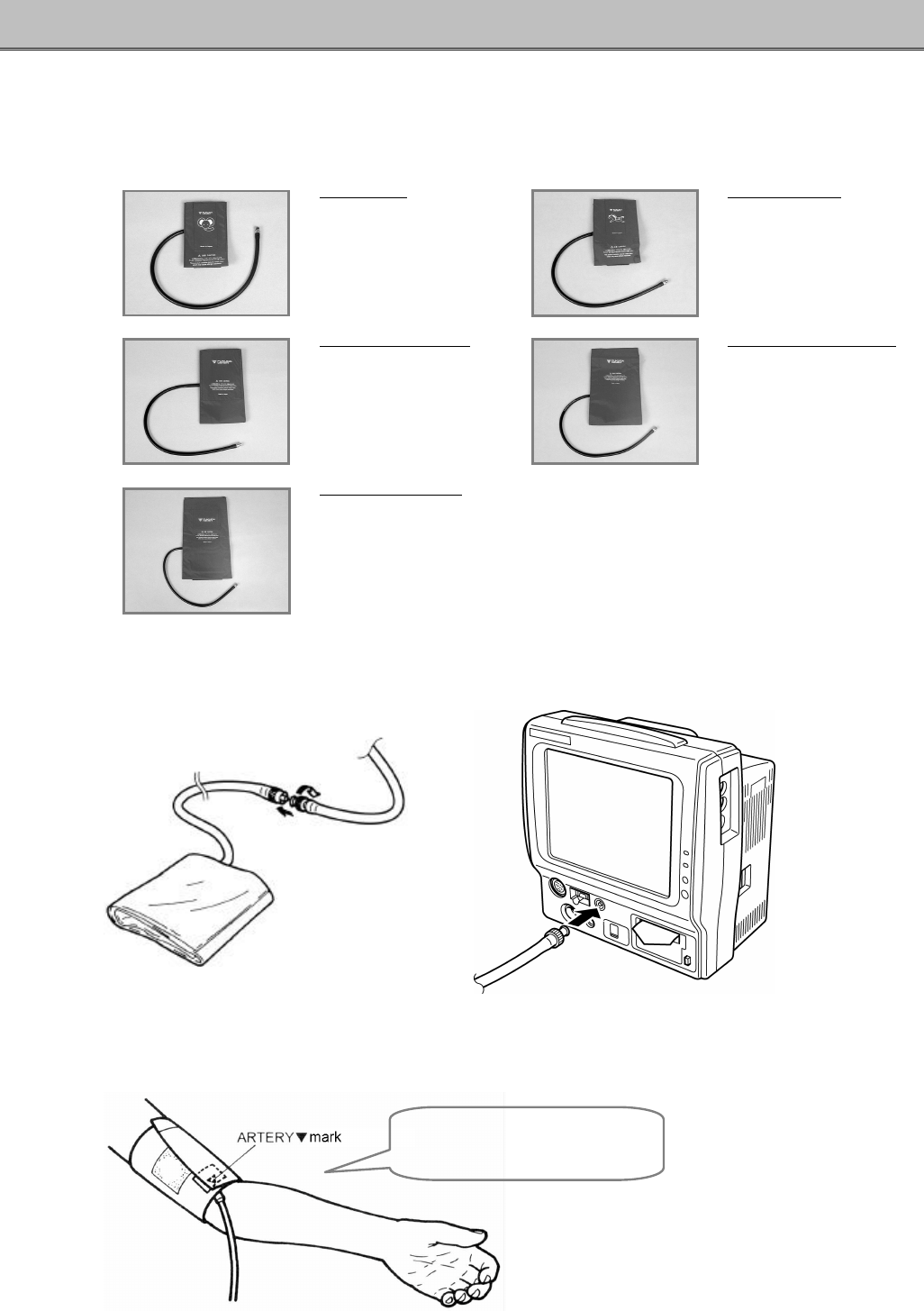
3−14
− To Measure the NIBP−
1. Select the appropriate cuff type for the patient.
According to the AHA (American Heart Association) guideline, the appropriate cuff width is 40% of
the arm circumference.
Select the appropriate cuff from the following selections.
Infant Cuff
CUF-7105
Width 8.5cm
Pediatric Cuff
CUF-7104
Width 10.5cm
Adult Cuff (small)
CUF-7103
Width 11cm
Adult Cuff (medium)
CUF-7102A
Width 14.5cm
Adult Cuff (large)
CUF-7101
Width 17cm
2. Connect the cuff to the air hose, and then connect the air hose to the cuff connection
connector on the monitor.
3. Apply cuff to the patient.
Position the ARTERY▼mark over the artery on the patient’s arm and wrap the cuff around.
A finger should just fit in
between the cuff and arm.
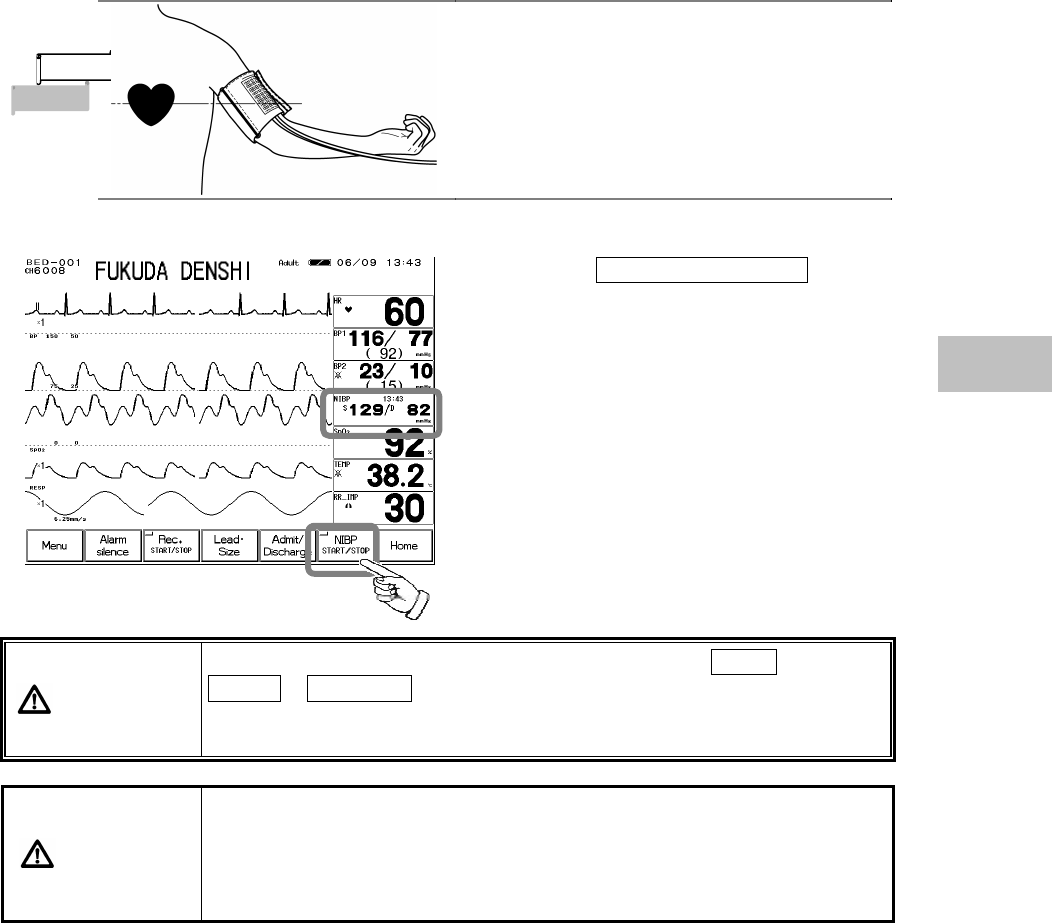
3−15
Check Point
Align the cuff height and heart position to eliminate
an error caused by the blood weight.
It is most appropriate to measure with the patient
lying down and arms naturally extended.
4. Start the measurement.
Pressing the NIBP START/STOP key will
start inflating the cuff pressure and starts the
measurement.
Upon completion, the measured value will be
displayed inside the NIBP parameter key.
WARNING
Before the measurement, make sure the patient type ( Adult /
Child / Neonate ) is properly selected. Otherwise, correct
measurement can not be performed, and congestion or other injury may
result.
CAUTION
?
Pay attention when measuring the NIBP of patient with bleeding
disorders or hypercoagulation. The cuff inflation may cause petechia
or circulatory failure by the blood clot.
?
If the air hose is twisted, or weighed down, the cuff air can not be
exhausted. Properly arrange the cuff and air hose.
3
To Measure the NIBP
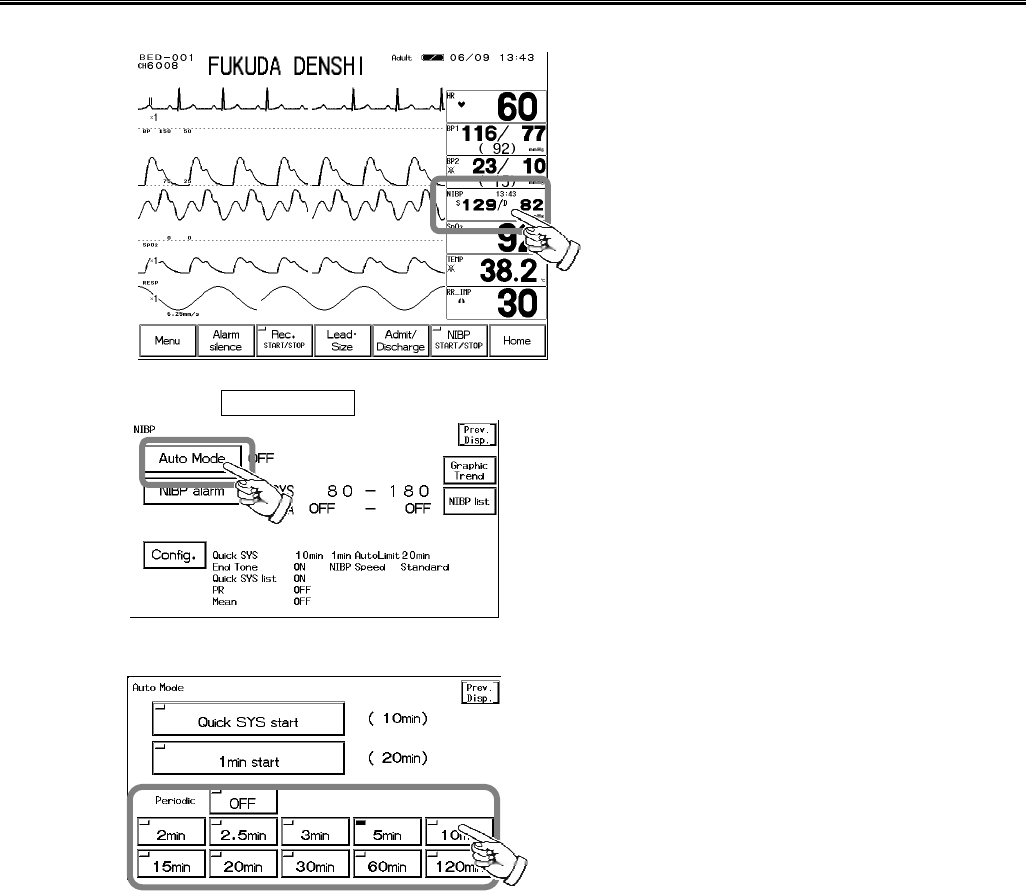
3−16
Procedure for Periodic Measurement
1. Press the NIBP parameter key on the home display.
The NIBP setup menu will be displayed.
2. Press the Auto Mode key on the NIBP setup menu.
The interval time setup menu will be displayed.
3. Select an interval time.
Press the key for the desired interval. Check that
the key LED is lighted for the selected interval.
The measurement will automatically start at the
selected interval.
The measurement time will be integral multiple of the selected interval time starting from 0 minute.
Ex.) If the present time is 13:14, the measurement time will be as follows for each interval time.
2 min. : 13:16, 13:18, 13:20, …
2.5 min. : 13:15, 13:17:30, 13:20, …
3 min. : 13:15, 13:18, 13:21, ….
5 min. : 13:15, 13:20, 13:25, …
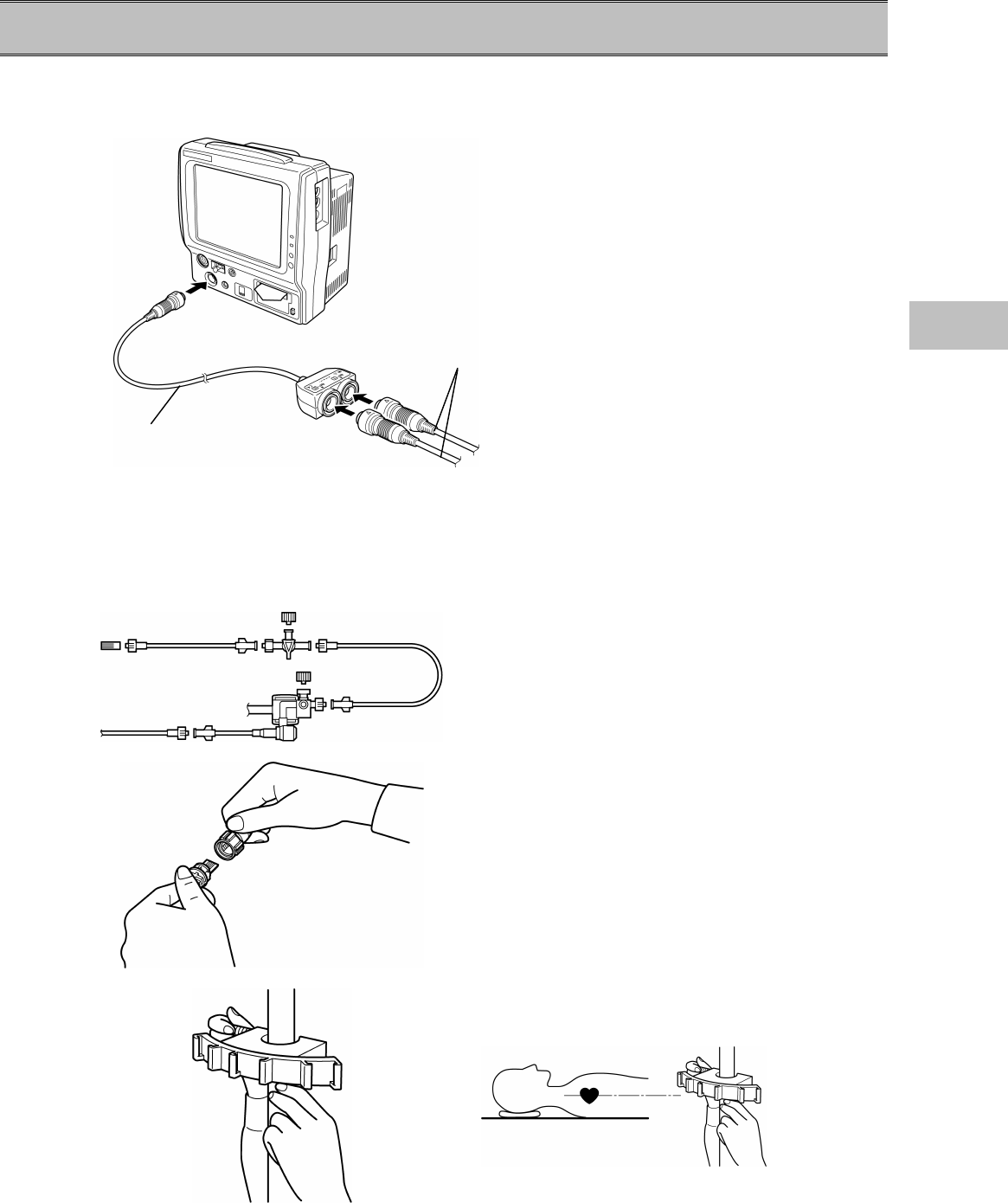
3−17
− To Measure the BP −
1. Connect the 2ch BP conversion cable to the monitor and interface cable.
2 channels of BP can be measured on this monitor.
Connect the monitor and the interface cable via
2ch BP conversion cable.
2. Assemble the BP measurement device.
The following procedure explains the case when BP transducer (COBE CDX series, No.041-575-
504) is used.
If using other transducers, refer to the operation manual for the corresponded transducer.
(1) Check if the package of the transducer is not
damaged before opening.
Verify that each connector is securely connected.
(2)Align the bracket to patient’s heart position (about
1/2 of the chest depth).
2ch BP Conversion Cable
Interface Cable 3
To Measure the BP

3−18
(3)Inject the heparin 1000 units to saline bag, mix
thoroughly and puncture the infusion line through
the same hole. Set the saline bag to pressure
bag, and hang from the infusion device. Fill
saline to about 1/3 of the drip.
(4)After loosening the zero-port plug, push the flash
button to perform priming to remove air bubbles.
(5)Verify that all air bubbles are removed, and tighten
the zero-port plug.
Turn on the zero-port plug side of the open-air
three-way cock.
(6)Inflate the pressure bag to 300mmHg.
(7)Wait about 5 minutes after setting the blood
pressure device.
Next procedure is to perform the zero balance.
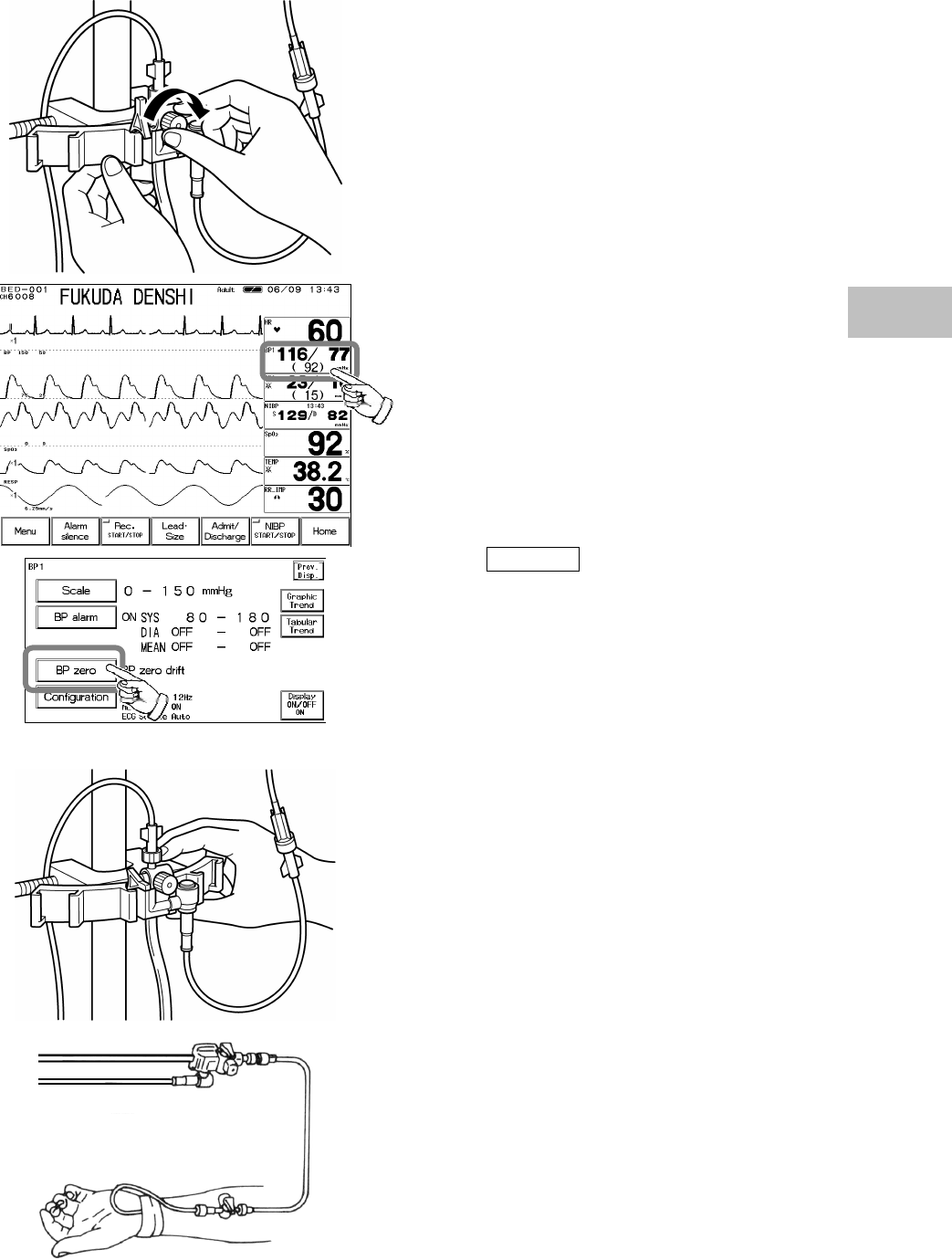
3−19
2. Perform zero balance.
(1) Loosen the zero-port plug on open-air three-way
cock one-half turn.
(2) Press the BP parameter key on the home display.
The display will proceed to BP setup menu.
(3) Press the BP Zero key on the BP setup menu.
Zero balance will start.
(4) Turn off the zero-port plug side of the open-air
three-way cock.
(5) Connect the catheter to the end of monitoring line.
The preparation for measurement is complete.
3
To Measure the BP
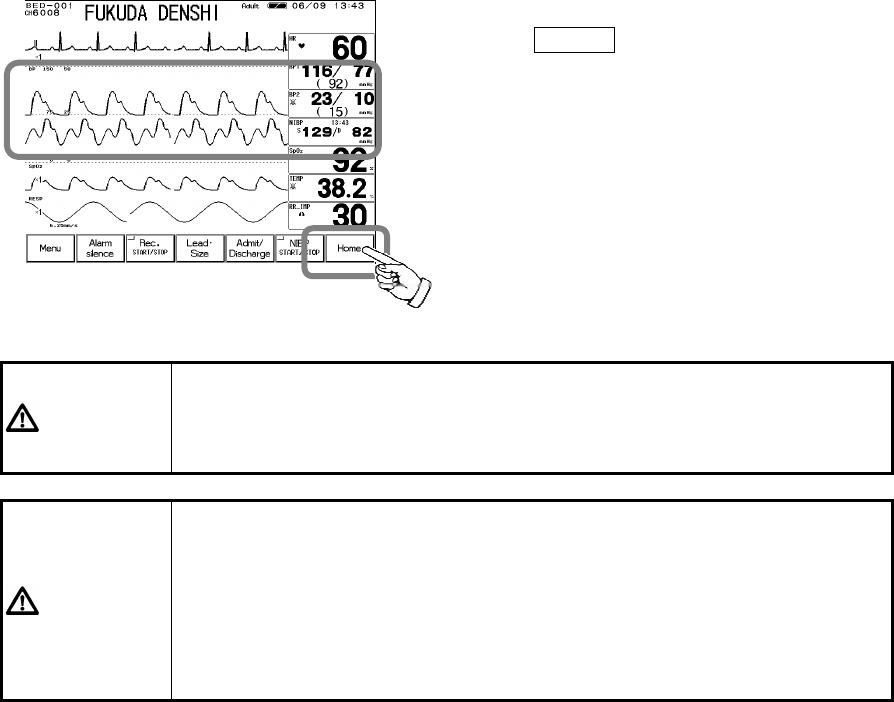
3−20
3. Start the BP monitoring.
Start the BP measurement.
Press the Home key. Verify that the BP
waveform and each measurement value is
displayed on the home display.
CAUTION
If the SYS value is abnormally high, or DIA is abnormally low, a resonance
may be the cause. If the resonance can not be eliminated by adjusting the
blood pressure filter, check the BP line and use a thick, short, and hard
catheter.
CAUTION
The zero balance procedure is required for the following case.
?
When starting a measurement.
?
When the heart position has changed due to body movement.
?
When the transducer position has changed.
?
When measuring for a long period of time and there is a possibility of
measurement error due to change in ambient temperature, etc.
?
When a connector is connected / disconnected, or a transducer is
replaced.
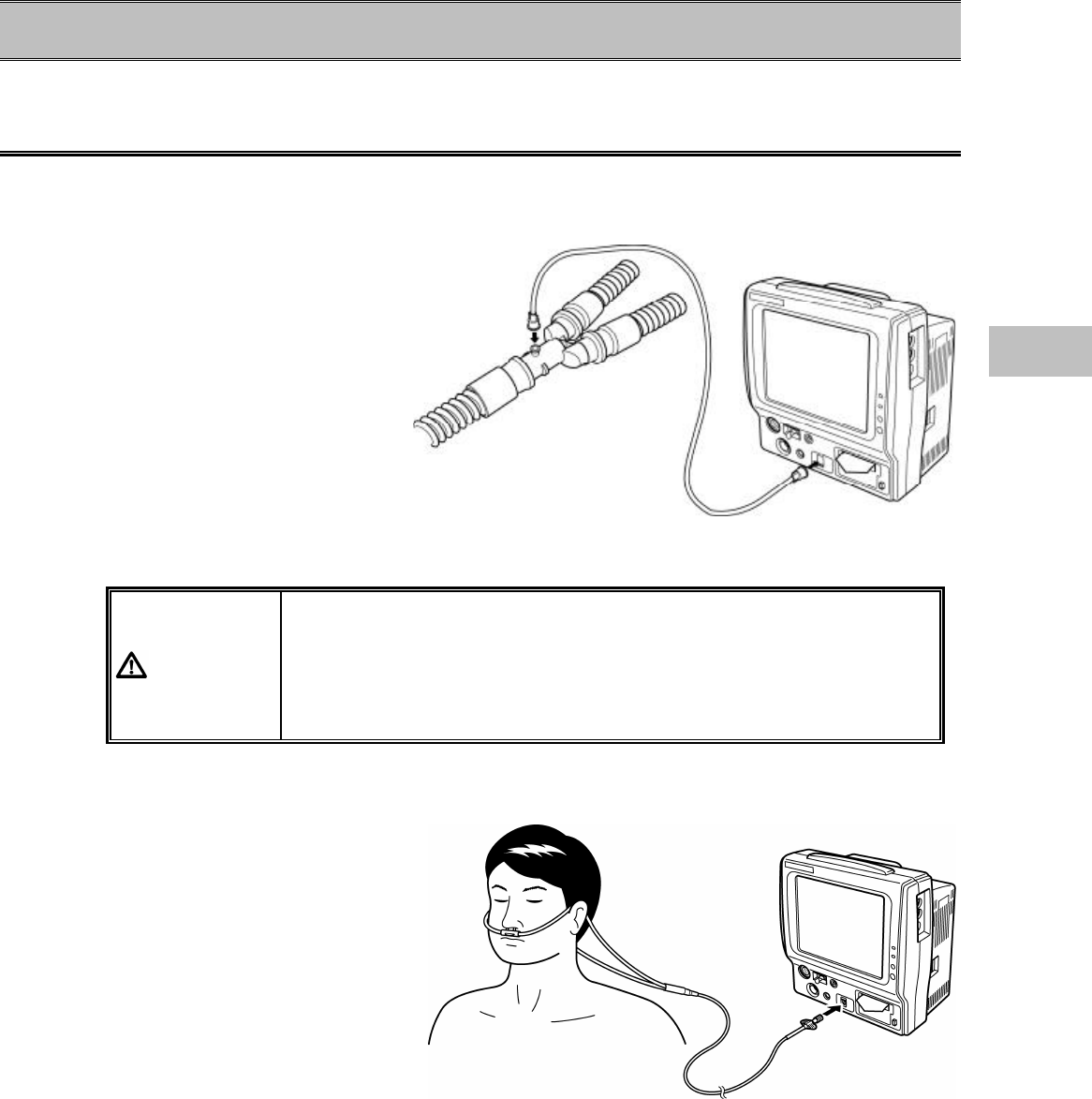
3−21
−To Measure the CO2 Concentration −(DS-7141)
The DS-7141 incorporates CO2 measuring unit.
Patient Application and Display
1. For intubated patient
(1)Attach the airway adapter to respiration circuit.
(2)Remove the protective cap on
the airway adapter, and
connect to the sampling tube.
(3)Connect the other end of the sampling tube to the patient monitor.
Verify that all the tubes are properly connected.
WARNING
?
Use the specified sampling tube and nasal prong manufactured by
Oridion.
?
Always consider the circumference of the intubation tube when using
the airway adapter. If inappropriate airway adapter is used for a
patient with low ventilation, CO2 may mix in to the inspired air resulting
in incorrect measurement, or apnea detection may become difficult.
2. For patient using the nasal prong
(1)Attach the nasal prong to the patient.
(2)Connect the nasal prong to the
patient monitor. Verify that it is
properly connected.
3
To Measure the CO2 Concentration
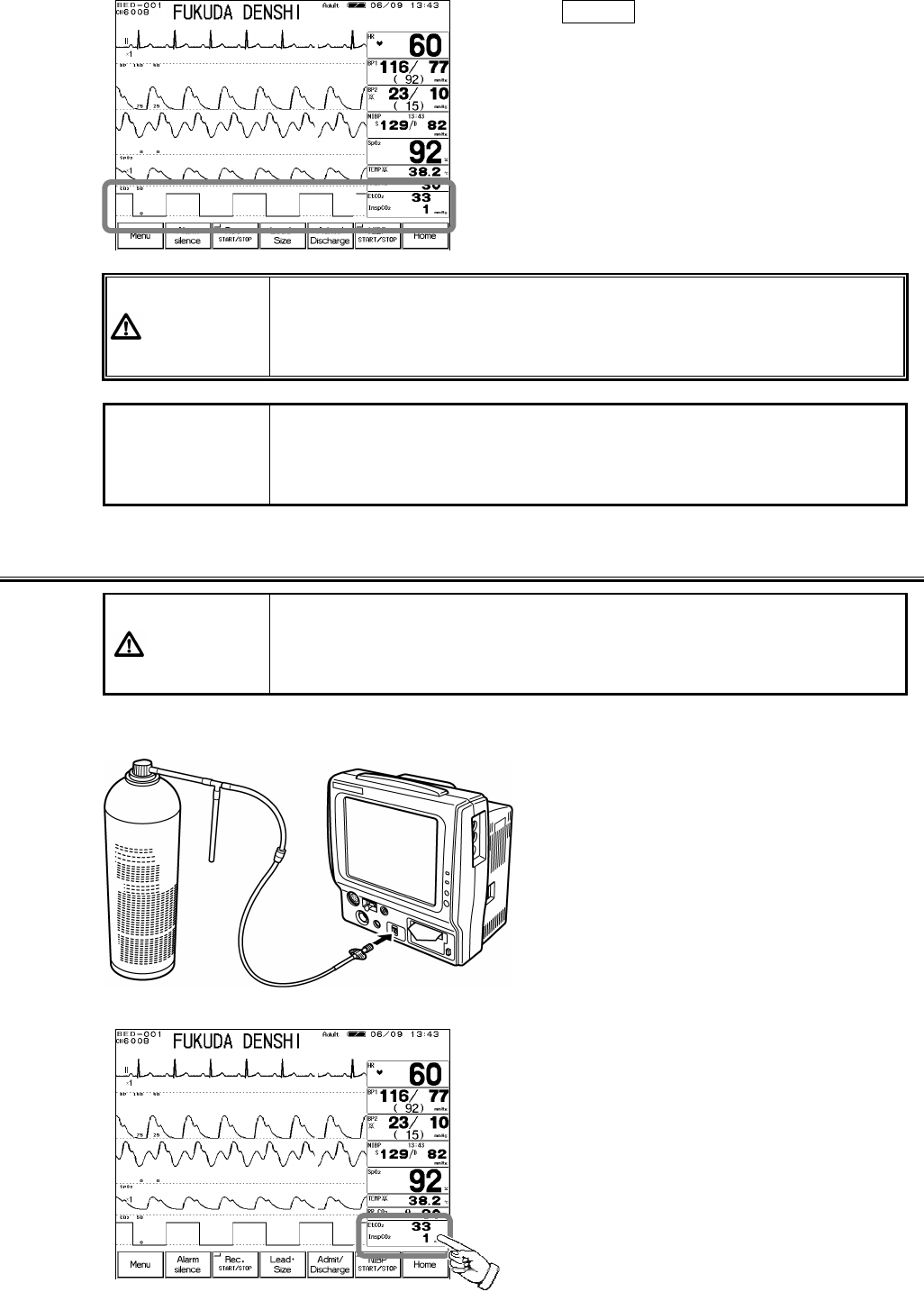
3−22
3. Start the CO2 measurement.
Press the Home key.
Verify that the CO2 waveform and EtCO2 numeric
data are displayed on the monitor.
Stable measurement can be achieved after about 20
minutes from power ON.
WARNING
When measuring CO2 concentration of a patient treated with mouth-to-
mouth resuscitation, Jackson-Rees circuit, Mapleson D circuit of which
CO2 gas may mix in, the value may be displayed lower than the actual
value.
NOTE
Connecting a sampling tube or nasal prong to the patient monitor will
automatically start the sampling pump. To prevent the pump from
deteriorating, disconnect the sampling tube and nasal prong from the
patient monitor when not measuring the CO2 concentration.
Procedure for Calibration (Every 6 Months)
CAUTION
?
Perform calibration after 20 minutes has elapsed since the patient
monitor is turned ON.
?
Do not disconnect the sampling tube during calibration. Calibration
will cease when the sampling tube is disconnected.
1. Connect the calibration gas cylinder to the patient monitor.
2. Press the CO2 parameter key on the home display.
Proceed to the CO2 setup menu.
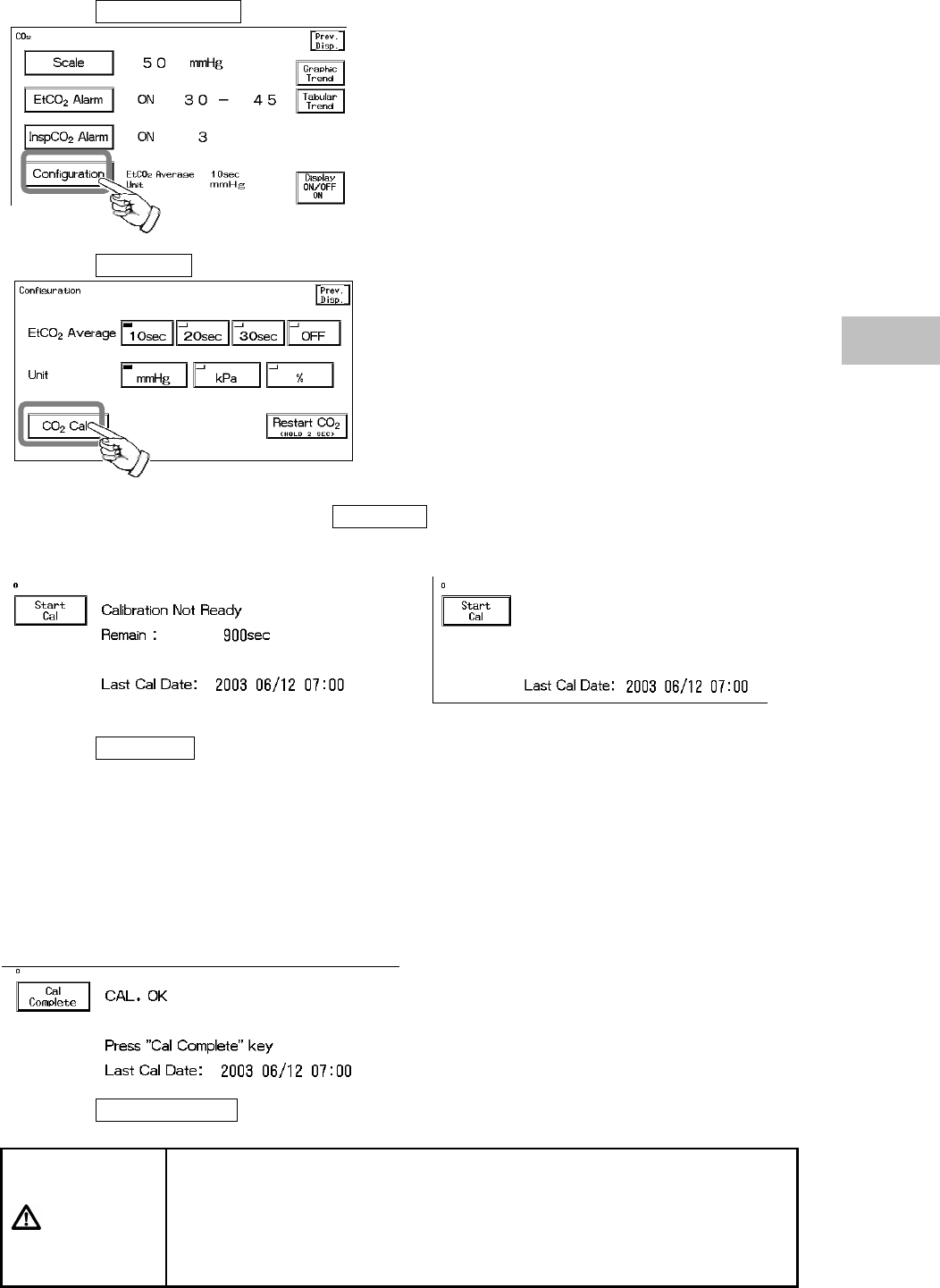
3−23
3. Press the Configuration key on the CO2 setup menu.
Proceed to the CO2 configuration menu.
4. Press the CO2 Cal. key on the CO2 configuration menu and display calibration menu.
Due to precision matter, CO2 calibration can not be started until 20 minutes has elapsed after the
power is turned ON. During this time, Start Cal key will be displayed in gray which indicates
that the key is ineffective. The message, “Calibration not ready” and the remaining time for
preparation will be displayed.
<Preparing for calibration> <Start calibration>
5. Press the Start Cal key and conduct calibration according to the displayed messages.
6. The message, “Feed CAL. GAS” will be displayed. Press the injection button and inject
the calibration gas.
7. The message, “Calc. Gas can be removed” will be displayed. Stop pressing the injection
button and cease the injection.
8. The message, “CAL. OK” will be displayed. “Last Cal. Date” will be updated to the current
date.
If any of the following messages is displayed, start the procedure again from step 2.
“CAL. error”, “CAL GAS error”, “Auto Zero fail”, “No stable gas flow”, “CAL. failure”
9. Press the Cal Complete key to end the calibration.
CAUTION
Conduct CO2 calibration for the following case.
?
When 6 months has elapsed from the last calibration date.
?
When EtCO2 measurement is not stable or accuracy is degraded
compared with other measuring device.
?
When the patient monitor was not used for a while, or when EtCO2 was
not measured for a while.
The Microstream technology developed by Oridion Co, Ltd. is used for the CO2 measurement.
3
To Measure the CO2 Concentration
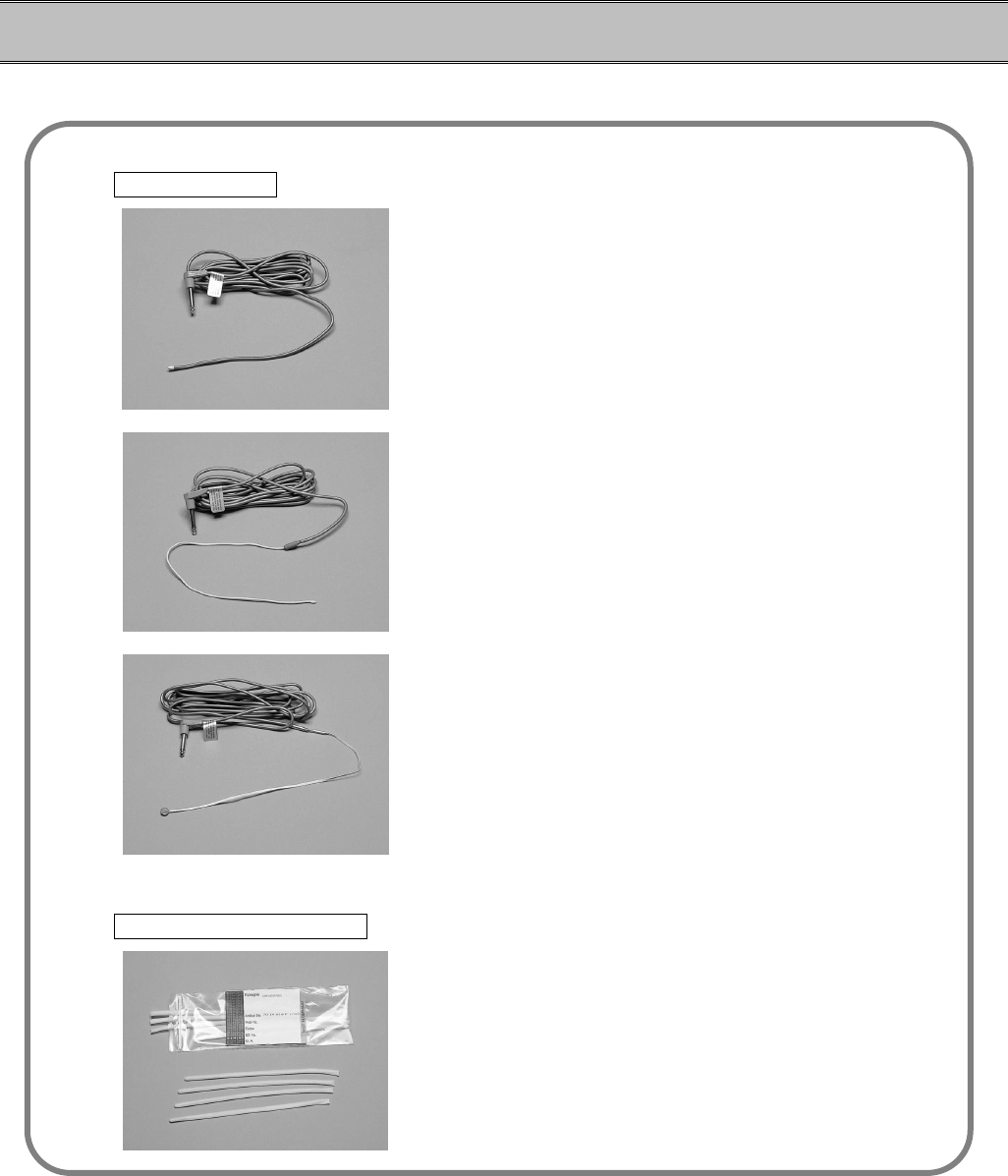
3−24
− To Measure the Temperature −
1. Select an appropriate type of probe for the patient.
Probe Type
Reusable Type Rectal Probe (adult) 401J
Rectal Probe (pediatric) 402J
Body Surface Probe 409J
Probe Cover (disposable) Probe Cover for 401J (10 covers)
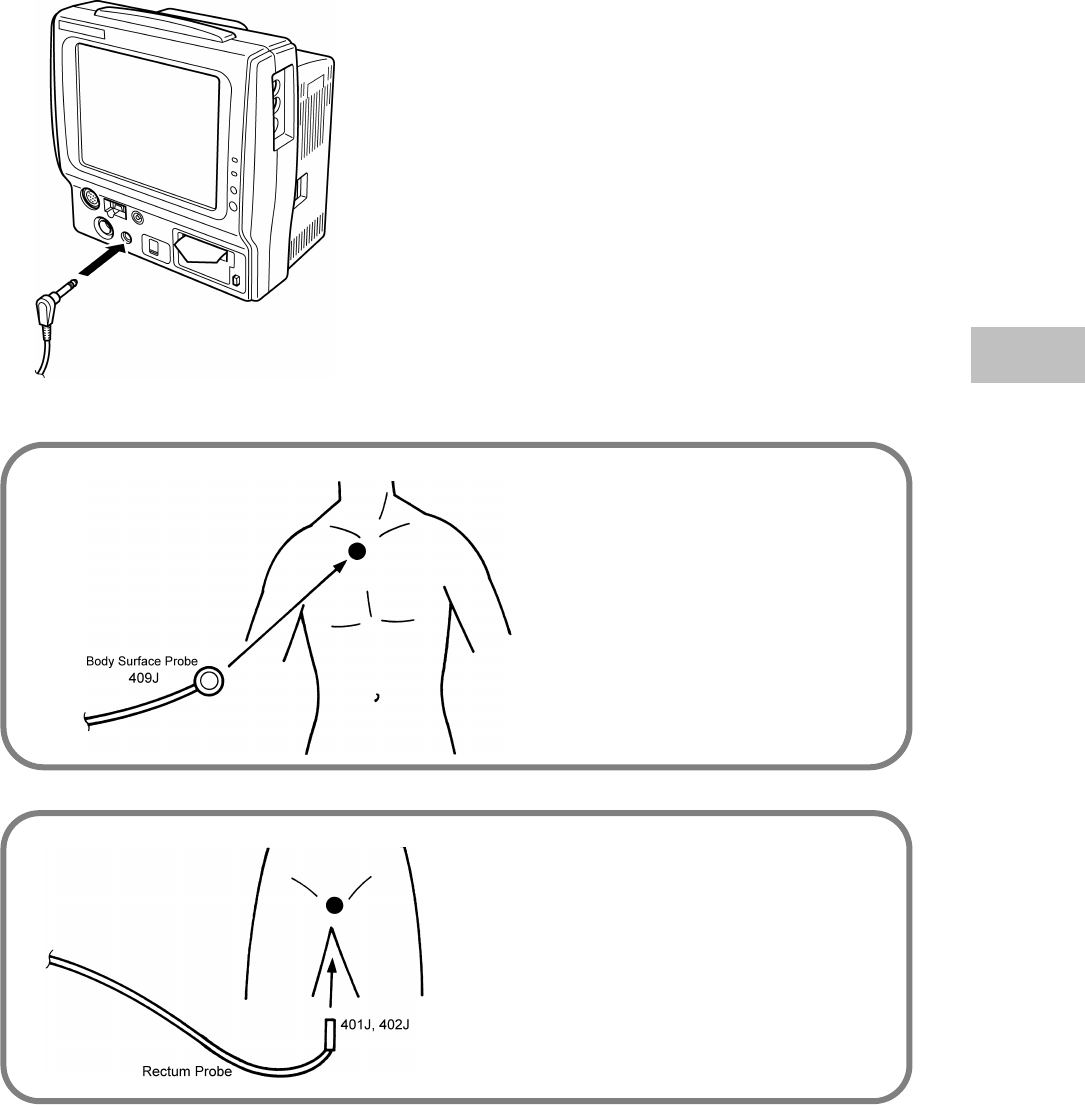
3−25
2. Connect the probe to the patient monitor.
3. Attach the probe to the patient.
●Body Surface
Attach the probe to the location
shown on illustration, and fixate
with surgical tape.
●Rectum
(1) Attach the probe cover to the probe end.
(2) Insert the probe into the rectum about 3~7
cm.
(3) Fix on the probe to inner thigh with surgical
tape.
3
To Measure the Temperature
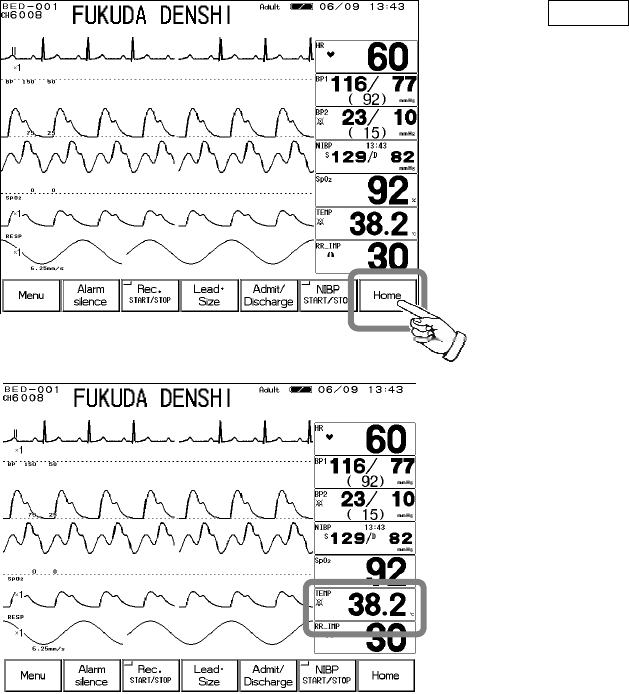
3−26
4. Check that the temperature is displayed.
Press the Home key.
Check that the temperature measurement is
displayed on the home display.